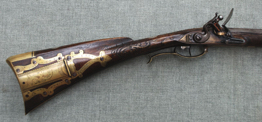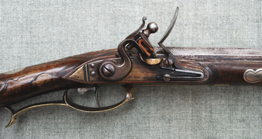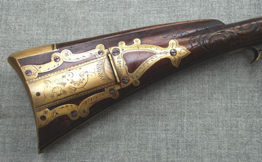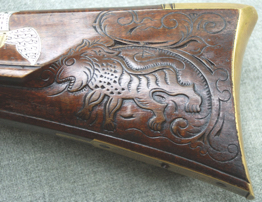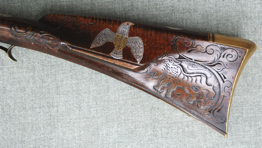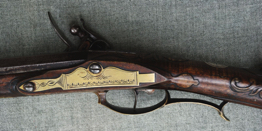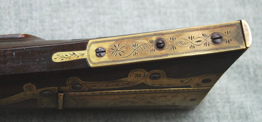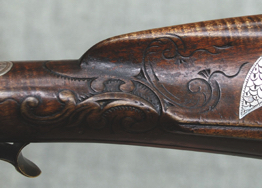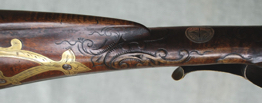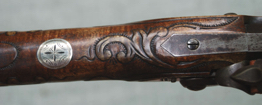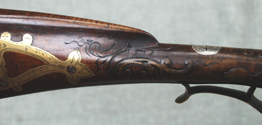Peter Angstadt was born in Rockland Township, Berks County in 1763 to gunsmith Adam Angstadt by whom it is most likely that he was trained. He lived his entire life in Rockland Township, one of the townships in the southeastern portion of the county that lie south of Kutztown, and took up gunmaking following service in the Revolution. Peter died in 1815, so his period of rifle production was somewhat limited to the approximate thirty year period between 1785 and 1815. A good number of his rifles are known to have survived and quite a few of them display the style illustrated here (likely representing the earliest of his production ca. 1785-1795). While his style did change somewhat as time progressed, even unsigned pieces are easily recognizable.
One thing which merits a brief discussion is to reiterate that I am currently discussing the work of the 1763-1815 Peter Angstadt, this man being the second of three known men with the given name ‘Peter’ to practice gunsmithing within the large Angstadt family. Peter’s father Adam also had a brother named Peter who was a practicing gunsmith (no surviving signed work) and there was a later Peter Angstadt, a nephew of the Peter herein discussed, who was working in the region around Kutztown ca. 1820s through the mid 19th century. A number of this man’s (Peter III) rifles are also known, sometimes being mis-attributed to the 1763-1815 Peter although they are clearly later work of weaker and notably different stylistic form.
A very succinct—and simplistic—manner of describing Peter’s work is the term “hasty.” When I speak of "haste" being present in Peter's work, I don't mean to indicate either low-quality or incompetence. However, the manner in which he constructed and decorated his rifles points toward a provincial alternative (again, consider the location) to more expensive and cosmopolitan pieces out of Reading, Allentown or Philadelphia. Peter seems to have been working in a little insular bubble, perhaps one of the reasons his work is so distinctive. The entire area itself was in fact generally within the same insular bubble right up into the early/mid 20th century, certainly in terms of culture.
I do not believe that Peter was taking conscious pains to 'clean up' his woodworking to any appreciable degree. I have seen very little in the way of scraper evidence (other than some half-hearted afterthoughts around the relieved areas of carving), but rather see much evidence of file usage upon the wood to smooth it. This also ties in with the manner of inlay installation and the generally good number of inlays, which render a scraper somewhat more difficult to use. I think he utilized some form of abrasive after this process - probably after staining or varnishing - to create a smooth surface. This is somewhat parallel to the practice of luthiers in working with rather rough wood finishing techniques and relying upon the grounding and varnishing materials to basically act as 'fillers' to gloss-over the coarse, speedy nature of the woodwork. Peter's reliance upon the copious use of chip-cuts around the carved design to offer more depth in shading (illusory) likewise allowed him to angularly dig-in to accomplish any desired relieving without having to work outwards to an appreciable degree to level the field. Lastly, the manner in which his carving and engraving was executed belies a fair degree of haste. Again, I do not see it as unaccomplished—quite the opposite. He was apparently confident enough in his manner of decoration that he did not second-guess himself nor see the need to refine and overwork the piece. A good friend of mine is fond of comparing ideal kentucky rifle construction to that of washing dishes at the kitchen sink: you perform the task in somewhat of a mechanized manner, without much thought. You don't wash dishes twice! This is how I interpret of Peter's work—the design of a scroll or a particular engraving cut may not be academically perfect, but they are this way solely because there is no need for them to be 'perfect.' He very obviously zipped through his engraving in a speedy manner making good use of regional folk forms as decorative elements. He also made good use of a parting tool to work equally quickly through the carving, incorporating some of the same wonderful folk elements into the more typical forms of rifle decorative design.
This rifle was a time-consuming project incorporating a great deal of research, custom brasswork in order to properly render Peter’s style, a custom flintlock mechanism and an enormous amount of effort to suppress the modern urge toward perfection. Such over-work would have completely smothered the spirit of Peter Angstadt’s art and rendered what was intended to be a great tribute, a gross insult. Overall, this piece is quite well-antiqued.

